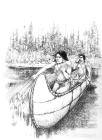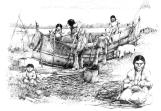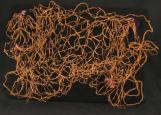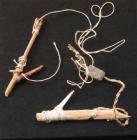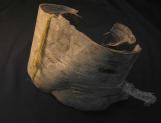1
First Nations Camps and TravelThe Saskatchewan River has been a transportation route and a source of sustenance for First Peoples for countless generations. One location of consistent use and settlement is the site where the Town of The Pas now stands on the bank of the Saskatchewan River.
A natural camp site in an area surrounded by the wetlands of a huge river delta, this site has been used for over 7,000 years, as evidenced by local archaeological findings. First Peoples exploited the resources of the river and the surrounding boreal forest for their subsistence. The forest provided wood for shelter, containers, medicine, berries, roots, birds and animals. The river provided fish, waterfowl, and the means for transportation.
2
IniniwukThe name "Cree" comes from the word French fur traders used for the First Nations people near James Bay. The French called these people "Kristineaux", their adaptation of the name these people called themselves. Kristineaux became shortened to Kri, spelled "Cree" in English. Most Cree use this name only when speaking or writing in English.
Canada has several groups of Cree-speaking people. There are many branches of the Cree nation spread across the country and are typically divided into the Plains Cree, Woodland Cree, Swampy Cree and Moose Cree. Originally they were all woodland people and spoke the Algonquian language of Eastern Canada. The Swampy Cree of west-central Manitoba, including those in the area of The Pas, have their own term - "Ininiwuk" - to describe themselves. The term translates roughly as "first people".
3
Water TravelWater travel in this region was the transportation mode of choice, not surprisingly when considering the alternative - overland treks through forests of dense vegetation and countless swamps and wetlands. Furthermore, the hauling of loads could be accommodated much more easily in watercraft than overland, although canoes and cargo had to be portaged around rapids and between watersheds. Fluctuating water levels also compounded the challenges of water travel with increased need for portaging when rivers were low and connector streams not navigable.
5
Birch Bark CanoeThe Saskatchewan River and its tributaries were major travel routes for the people of this northern region. During the open-water months travel was by canoe. The birch bark canoe was a masterpiece of innovative design - perfectly suited to travel along forest waterways. It was lightweight and maneuverable for negotiating the twists and turns of serpentine rivers and creeks. It could be portaged overland around obstructions, and was made from materials readily available in the surrounding forests – materials always at hand to make the inevitable repairs.
7
Constructing birchbark canoes was a family affair for the Ininiwuk who passed their skills on to each successive generation. Canoe building would start in the early spring when the tree sap was rising. Large sections of bark were cut from birch trees with sharp stone knives and fitted over a gunwale frame supported by stakes in the ground. This frame held the bark pieces together and provided the shape for the vessel.Wood for ribs was cut, thinned, soaked in hot water to become pliable, and then fitted to create an inside frame. Wood was also used to fashion thwarts and gunwales, expertly shaped with stone scrapers and knives. Once all of these pieces were assembled, they were lashed and sewn together with 'watape' - long sections of split spruce root. The stitching holes were water-proofed with boiled spruce gum, mixed with wood ash.
